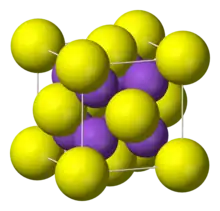Caesium sulfide
Caesium sulfide is an inorganic salt with a chemical formula Cs2S. It is a strong alkali in aqueous solution. In the air, caesium sulfide emits rotten egg smelling hydrogen sulfide.
 | |
| Names | |
|---|---|
| IUPAC name
Caesium sulfide | |
| Identifiers | |
3D model (JSmol) |
|
| ChemSpider | |
PubChem CID |
|
CompTox Dashboard (EPA) |
|
| |
| |
| Properties | |
| Cs2S | |
| Molar mass | 297.876 |
| Appearance | white crystal |
| Density | 4.19 g·cm−3[1] |
| Melting point | 480 °C[2] |
| hydrolyses to form caesium bisulfide[3] | |
| Solubility in ethanol and glycerol | soluble |
| Structure | |
| cubic, anti-fluorite | |
| Hazards | |
| Main hazards | toxic |
| GHS pictograms |   |
| GHS Signal word | Danger |
| H314, H400 | |
| P260, P264, P273, P280, P301+330+331, P303+361+353, P304+340, P305+351+338, P310, P321, P363, P391, P405, P501 | |
| Related compounds | |
Other anions |
caesium oxide caesium selenide caesium telluride caesium polonide |
Other cations |
potassium sulfide, lithium sulfide, rubidium sulfide, sodium sulfide, francium sulfide |
Except where otherwise noted, data are given for materials in their standard state (at 25 °C [77 °F], 100 kPa). | |
| Infobox references | |
Production
Similar to sodium sulfide, anhydrous caesium sulfide can be produced by reacting caesium and sulfur in THF. It needs ammonia or naphthalene to react.[4]
- 2Cs + S → Cs2S
By dissolving hydrogen sulfide into caesium hydroxide solution, it will produce caesium bisulfide, then it will produce caesium sulfide too.[5][6]。
- CsOH + H2S → CsHS + H2O
- CsHS + CsOH → Cs2S + H2O
References
- Sommer, Helmut; Hoppe, Rudolf. The crystal structure of cesium sulfide and a remark about cesium selenide, cesium telluride, rubidium selenide, and rubidium telluride (in German). Zeitschrift fuer Anorganische und Allgemeine Chemie, 1977. 429: 118-30. ISSN: 0044-2313
- Dale L. Perry, Sidney L. Phillips: Handbook of inorganic compounds. CRC Press, 1995, ISBN 978-0-8493-8671-8, S. 336 (, p. 336, at Google Books).
- Jean D'Ans, Ellen Lax: Taschenbuch für Chemiker und Physiker. 3. Elemente, anorganische Verbindungen und Materialien, Minerale, Band 3. 4. Auflage, Springer, 1997, ISBN 978-3-5406-0035-0, S. 692 (, p. 692, at Google Books).
- J.-H. So and P. Boudjouk (1992). N. G. Russell (ed.). "Hexamethyldisilathiane". Inorganic Syntheses. doi:10.1002/9780470132609.ch11.
- Wilhelm Blitz, Ernst Wilke-Dörfurt: "Über Sulfide des Rubidiums und Cäsiums" in Zeitschr. f. anorg. Chem. 1906. 48, S. 297–317. Volltext
- R. Abegg, F. Auerbach: 'Handbuch der anorganischen Chemie'. Verlag S. Hirzel, Bd. 2, 1908. S. 430.Volltext
This article is issued from Wikipedia. The text is licensed under Creative Commons - Attribution - Sharealike. Additional terms may apply for the media files.